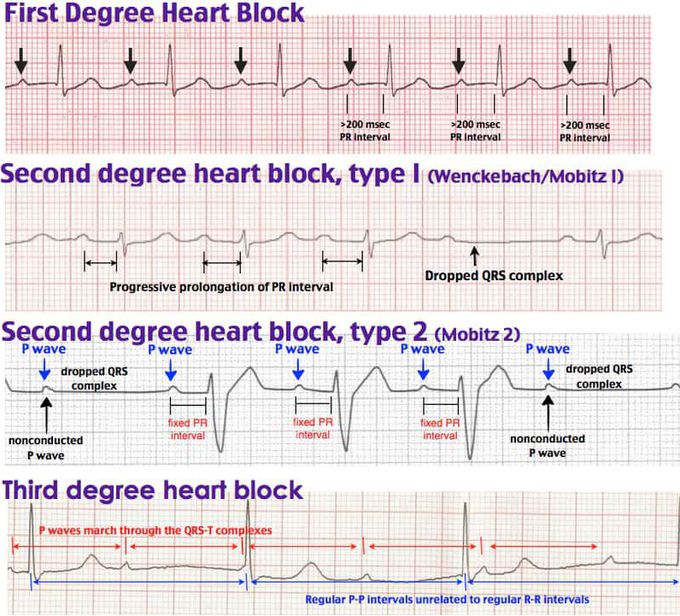

Reda_ja3likalmost 5 years ago

(To Aishah 🌸)(Part 1)🤓Atrioventricular (AV) block Aka heart block. Causes Idiopathic RCA infarct (inferior MI), as this supplies the AV node. Myocarditis Drugs: β-blockers, calcium channel blockers, adenosine, digoxin, cholinesterase inhibitors. 1st degree AV block Prolonged PR interval (>0.2 seconds, 5 small squares). No treatment required. 2nd degree AV block Intermittent conduction of the P wave to the ventricles. The conduction ratio is the number of P waves to QRS complexes e.g. 4:3. A conduction ratio of 2:1 is untypable as it is hard to determine if there is progressive PR prolongation. High grade 2nd degree block is when 2 consecutive P waves fail to conduct to the ventricles. The P waves are regular, distinguishing it from ectopic atrial contractions. 2nd degree AV block type 1 Aka Mobitz type 1, or Wenckebach. Progressively prolonged PR interval until a P wave fails to transmit to the ventricles. No treatment required. Can sometimes be hard to distinguish from Mobitz type 2 when increases in PR are small. Look for the biggest increase, which is between the 1st and 2nd PR after the missed QRS. 2nd degree AV block type 2 Aka Mobitz type 2. Constant PR interval but intermittent failure to transmit to the ventricles. High risk of progression to 3rd degree block so often requires pacemaker treatment. 3rd degree AV block Aka complete heart block. No transmission of P waves into ventricles, with a ventricular escape rhythm taking over. QRS is usually wide, but occasionally the bundle of His provides the pacemaker and thus the QRS is narrow. HR 20-40. This is one cause of AV dissociation. Others include accelerated idioventricular rhythm (ectopic focus in ventricles with HR 50-110) and VT. Requires pacemaker.........................................Bundle branch blocks General features Blockage in the bundle branches, which lie between the bundle of His and the Purkinje fibres. Depolarisation instead spreads via the (slower) myocardium, causing broad QRS complexes. The altered depolarisation sequence also leads to altered repolarisation, and hence ST-T changes. Left bundle branch block (LBBB) Causes: Anterior MI (LAD). May be the initial ECG sign. HTN Myocarditis Cardiomyopathy Aortic valve disease. ECG: Deep, wide S in V1 and RSR' (M-shaped) in V6: SLaM (LBBB). V1: delayed LV depolarisation results in a deep, wide S wave. V6: right to left septal depolarisation, instead of the usual left to right, leads to initial R wave in V6 followed by a dip during RV depolarisation, then 2nd R wave as depolarisation reaches the LV. Same pattern seen in lead I. Often the middle notch of the M is very small, such that it simply looks like a broad R wave. Discordant T waves in V1 and V6. Criteria: {broad QRS} + {broad R in V6} + {broad S in V1 or 2}. Right bundle branch block (RBBB) Causes: Increased RV pressure: primary pulmonary HTN, cor pulmonale, PE. Acquired heart disease: anterior MI (LAD), myocarditis, cardiomyopathy. Congenital Iatrogenic e.g. cardiac catheterisation. Can also be a normal ECG variant in healthy individuals. ECG: rSR in V1 (M-shaped) and QRS (W-shaped) in V6: MaRroW (RBBB). Electrophysiology: the initial rS (V1) and QR (V6) reflect a normal left to right septal depolarisation and LV depolarisation. The delayed RV depolarisation leads to a 2nd broad R wave in V1 and a late 'slurred' S wave in V6. Instead of rSR, sometimes V1 simply has one large R ± a small notch as it rises. Criteria: {broad QRS} + {slurred S V6 and/or rSR V1} + {overall +ve QRS in V1}. Left anterior and posterior fascicular block Blockage in one of the two branches of the left bundle branch. LAFB is much commoner, and in isolation may simply be a benign feature of aging. Other causes include anterior MI, IHD, aortic valve disease, HTN, or cardiomyopathy. LPFB is associated with inferior MI or cardiomyopathy. Aka left anterior and posterior hemiblocks. ECG QRS normal or slightly prolonged (80-120 ms). LAFB: Left axis deviation. Small Q and tall R (qR pattern) in lateral leads (I and aVL) with prolonged R peak time (>45 ms) in aVL. Small R and deep S (rS pattern) in inferior leads. LPFB is the opposite: Right axis deviation. Small R and deep S in lateral leads. Small Q and tall R in inferior leads, with prolonged R peak time in aVF. Bifasciular and trifascicular block Bifascicular block: RBBB plus {LAFB or LPFB}. Conduction is via the single remaining fascicle. ECG: RBBB plus left or right axis deviation. Causes: IHD (50%), HTN (25%), aortic stenosis, anterior MI, congenital, ↑K+. Clinical significance uncertain, but carries a 1% annual risk of progression to complete heart block. Trifascicular block: May not be a clinically useful term. It implies blockage in right bundle plus both fascicles, which is essentially just 3rd degree AV block. In practice, it may be used to describe an incomplete trifascicular block where there is still partial/intermittent transmission in one of the fascicles, plus associated 1st/2nd degree AV block. Resulting ECG shows RBBB, LAFB or LPFB, and prolonged PR.
Other commentsSign in to post comments. You don't have an account? Sign up now!

